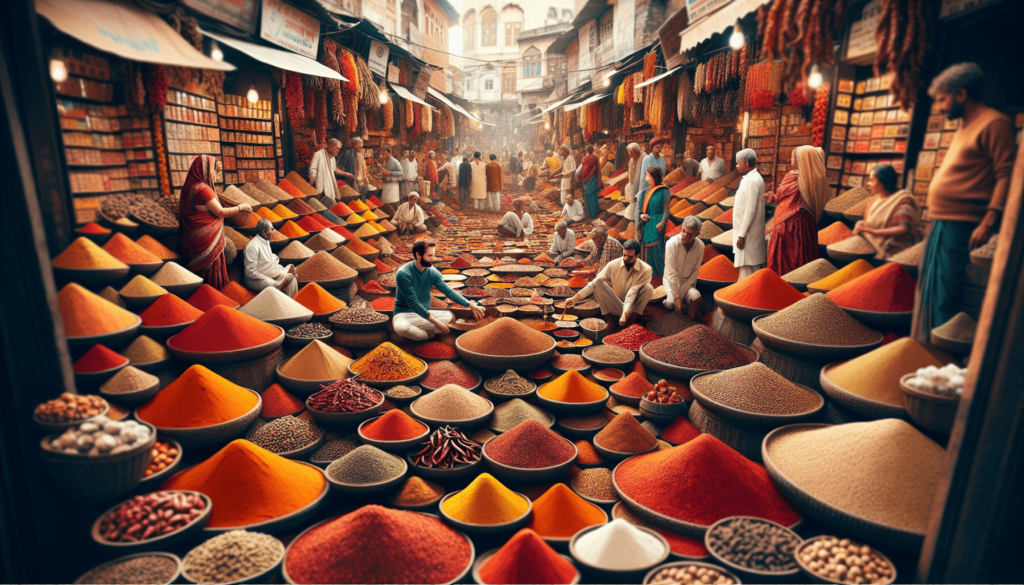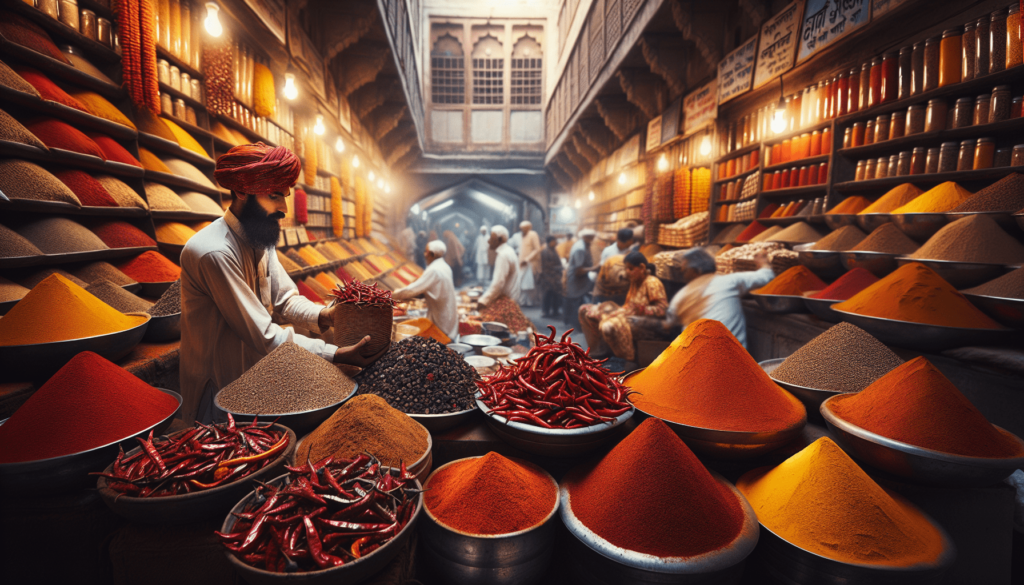Join us on a delightful adventure as we embark on a flavorful culinary journey through the vibrant spice markets of India. Immerse yourself in a symphony of exotic aromas, vibrant colors, and a plethora of spices that tantalize the senses. From the bustling streets of Delhi to the charming lanes of Jaipur, we’ll explore the richness of Indian cuisine and uncover the secrets behind the perfect blend of flavors that make Indian food so delectable. Get ready to awaken your taste buds and indulge in the incredible diversity that the spice markets of India have to offer.

Introduction to Indian Spice Markets
India is a land known for its vibrant culture, rich history, and delectable cuisine. At the heart of every Indian kitchen are the aromatic and flavorful spices that bring dishes to life. These spices are not just ingredients; they tell tales of ancient trade routes, cultural influences, and regional culinary traditions. To truly understand the magic of Indian cooking, one must explore the bustling spice markets that dot the country. In this article, we will take you on a culinary journey through the vibrant Indian spice markets, unveiling their historical significance, enticing aromas, diverse spice offerings, and the enchanting experience they offer.
Overview of Indian spice markets
Indian spice markets have played a pivotal role in the country’s history and cultural fabric. Dating back to ancient times, these markets have served as hubs for trade, connecting India with the rest of the world. Spices like pepper, cinnamon, cardamom, and cloves were highly valued and sought after by traders from Europe, Arabia, and beyond. Even today, these markets thrive as bustling centers of commerce, attracting locals and tourists alike with their diverse and aromatic offerings.
Historical significance of spice markets in India
Spices have shaped the course of history, and India’s spice markets have been at the center of it all. The spice trade routes established by ancient civilizations brought not only culinary ingredients but also cultural exchange, wealth, and power. Traders from all corners of the world journeyed to India to procure these precious spices, making spice markets the epicenter of commerce and cultural fusion. The tales of the Silk Road, the Dutch East India Company, and the British Raj all intertwine with the spice markets of India. Exploring these markets is like stepping back in time and delving into the historical tapestry that defines India’s relationship with spices.
Vibrant Colors and Aromas
As you step into an Indian spice market, prepare to be mesmerized by a riot of colors and an orchestra of aromas. The markets are a sensory feast, awakening your taste buds before you even set foot in a kitchen. The vibrant hues of red chili powder, golden turmeric, deep green cardamom pods, and earthy brown cumin seeds tempt your eyes, inviting you to discover the flavors they hold. The sweet-scented aroma of cinnamon, the pungent punch of coriander, and the exotic fragrance of cloves mingle in the air, creating an olfactory symphony that will leave you spellbound.
Exploring the visual and olfactory delights of Indian spice markets
Every corner of an Indian spice market is a kaleidoscope of colors. The stalls are adorned with jars, barrels, and sacks filled to the brim with an array of spices, each one more vibrant than the last. The sight of these spices, neatly arranged in their natural glory, is a feast for the eyes and a testament to the diversity of Indian cuisine. As you navigate through the bustling market, the scents wafting through the air guide your senses towards hidden treasures waiting to be discovered.
Variety of spices available in the markets
Indian spice markets are a treasure trove for spice enthusiasts. From the humble turmeric to the extravagant saffron, these markets offer a wide variety of spices that cater to every taste and culinary need. The markets boast an impressive assortment of spices, including the essential ones like cumin, coriander, fenugreek, black pepper, and cloves. You’ll also find unique regional spices like Kashmiri red chili, Bengali five-spice blend called panch phoron, and Malabar black pepper that add distinct flavors to regional cuisines. Whether you are a seasoned chef or a curious food lover, Indian spice markets are sure to leave you spoilt for choice.

Popular Spice Market Destinations
If you are an avid traveler seeking a culinary adventure, there are a few spice market destinations in India that should be on your bucket list. These iconic spice markets offer a glimpse into the rich tapestry of Indian culinary heritage and the vibrant cultural landscape that surrounds them.
Visit to Khari Baoli in Delhi
Located in the heart of Old Delhi, Khari Baoli is Asia’s largest wholesale spice market. Stepping into Khari Baoli is like entering a different world altogether. As you walk through its narrow lanes, you’ll be enveloped by a melange of sights, sounds, and smells. Traders hawk their wares, spices spill out onto the streets, and the potent aroma of masalas fills the air. From aromatic herbs and whole spices to exotic blends and dried fruits, Khari Baoli is a sensory overload that will leave you in awe.
Exploring the spice markets of Old Delhi
Old Delhi is a hotspot for spice markets, and its labyrinthine lanes hold a treasure trove of flavors waiting to be discovered. Chandni Chowk, one of the oldest and busiest markets in Delhi, is a hub for spice trade. The narrow streets are lined with shops selling spices of every kind, making it a haven for food enthusiasts. As you explore these markets, you’ll encounter shops that have been in business for generations, each with its unique charm and unforgettable aromas.
Kochi Spice Market in Kerala: A coastal culinary paradise
Kerala, nestled along the Arabian Sea, is a coastal paradise renowned for its lush green landscapes and vibrant culinary traditions. The Kochi Spice Market, located in the historic Fort Kochi area, offers a fascinating glimpse into the spice trade that has shaped the region’s history. Walking through the market, you’ll be transported to a bygone era as you witness the trading of spices that have attracted merchants from distant lands for centuries. The market is a harmonious blend of cultures, with spices like pepper, cardamom, turmeric, and cinnamon reflecting Kerala’s diverse cultural heritage.
Must-Have Spices
Indian cuisine is renowned for its depth of flavors, and the spices used play a crucial role in achieving the perfect balance of taste. While the sheer variety of spices can be overwhelming, there are a few must-have spices that form the foundation of Indian cooking.
Turmeric: The golden spice of life
Turmeric, known as the “golden spice,” is an integral part of Indian cuisine and Ayurvedic traditions. Its vibrant yellow color imparts a warm hue to dishes and adds a subtle earthy flavor. Turmeric is also renowned for its health benefits, with properties that aid digestion, boost immunity, and reduce inflammation. Whether used in vegetable curries, lentil soups, or even turmeric-infused milk, this versatile spice is a staple in every Indian kitchen.
Cardamom: The queen of spices
Cardamom, also known as the “queen of spices,” is treasured for its unique and aromatic flavor. It adds a sweet and floral essence to both savory and sweet dishes, making it a versatile spice in Indian cuisine. Whether used in flavorful biryanis, rich desserts, or aromatic masala chai, cardamom elevates the taste profile of any dish it graces. With its distinct flavor and delightful aroma, cardamom truly reigns supreme in Indian kitchens.
Cinnamon: A warm and aromatic delight
Cinnamon is a spice that needs no introduction. Its warm, sweet, and woody aroma is instantly recognizable and adds an enchanting touch to Indian dishes. From fragrant rice pilafs to decadent desserts like kheer (rice pudding), cinnamon imparts a subtle warmth that enhances the overall flavor profile. It is also known for its numerous health benefits, including its ability to regulate blood sugar levels and promote heart health.
Cumin: The versatile and earthy spice
Cumin seeds, with their distinct earthy flavor, are a staple in Indian cooking. They are either used whole or ground into a powder, lending their aromatic qualities to a wide range of dishes. Cumin is a key component of spice blends like garam masala and curry powder, adding depth and complexity to the flavors. It pairs beautifully with legumes, adding nutty undertones to lentil soups, stews, and curries. Additionally, cumin is well-known for its digestive properties, making it a popular inclusion in Indian cuisine.
Coriander: A fragrant herb with many uses
Coriander, also known as cilantro or dhania, is an herb that adds a refreshing and fragrant touch to Indian dishes. The leaves and seeds of the coriander plant are used extensively in Indian cooking. The fresh leaves, with their citrusy aroma, are a common garnish for curries, salads, and chutneys. The seeds, when ground into a powder, are an essential ingredient in spice blends and curry pastes. With its delicate flavor and versatility, coriander is a herb that cannot be ignored in the realm of Indian spices.

